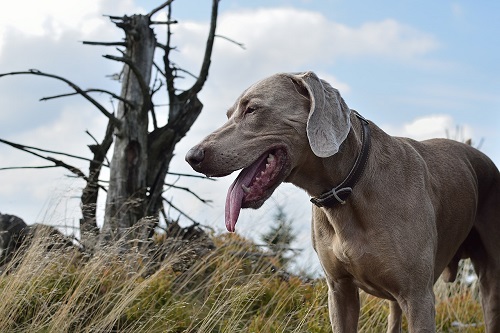Silvery-grey and with a sleek coat that rivals that of otters, the Weimaraner has been a dog of distinction since his breed’s beginnings in Germany. Only initially appearing in the US in the 1930s and 1940s, access to the bloodline of the Weimaraner breed was kept tightly controlled by German nobles through an exclusive club of dog owners and breeders.
This guide will be reviewing the personality and temperament of the Weimarer, his general characteristics, grooming advice, and a variety of other factors that contribute to this breed.
Weimaraner Temperament & Personality
The beautiful lines of his body, his keen sense of smell, and his often-underestimated, human-like intelligence makes him an attractive, if not a conventional, breed. Stubborn and energetic in turns, a Weimaraner is not a “set and forget” type of dog – he requires interaction and attention to maintain an even keel and display his breed’s best traits. Most owners would characterize their Weimaraner as being obedient and friendly and in some cases willful and assertive. Without proper training, he may try to run the household or become pack leader of the household.
Puppy Life to Adulthood: What To Expect
While just as sweet and endearing as all puppies, Weimaraner puppies have a few intriguing changes up their canine sleeves. The stark contrast of their silver coat with ice-blue eyes is beautiful, but it doesn’t last: as a puppy grows, his eyes will gradually change to a hazel or a darker grey-blue. Weimaraner puppies are also born with tabby-like stripes that resemble crumpled velvet – a decided departure from the smooth coats of a purebred mother and father Weimaraner. These stripes fade even more quickly than the pup’s eye color, however, and usually are completely gone in only a few days.
a hazel or a darker grey-blue. Weimaraner puppies are also born with tabby-like stripes that resemble crumpled velvet – a decided departure from the smooth coats of a purebred mother and father Weimaraner. These stripes fade even more quickly than the pup’s eye color, however, and usually are completely gone in only a few days.
Their newborn puppy whines are almost like humming, and breed enthusiasts note that even their adult barking tones lack the sharpness heard in other dogs. While they aren’t given to howling, they shouldn’t be considered a “quiet” breed: their genetic link to hunting hounds is clearly heard when a bold squirrel or rabbit gets too close to a Weimaraner’s backyard. He will bark enthusiastically at any perceived intruders, and will also happily chase small game, particularly as a young adult dog.
Weimaraners do experience severe canine separation anxiety when left alone, so they work best in households where a pet parent is home nearly all the time. Because of their natural inclination to run and exercise, they are also a poor fit for apartment or townhome living; they do best with access to a large, fenced-in yard to play in.
Grooming Weimaraners: Proper Breed Care
The smooth, silk-like quality of their coat is not without the drawbacks of shedding, though a few minutes with a bristle dog brush once or twice a week should cover it. While the traditional AKC-recognized Weimaraner is the short-coated breed most pet parents know and love, there are long-haired varieties bred by enthusiasts as well. These long-haired versions are considerably more rare and will need more extensive grooming (and potentially even professional grooming) to stay clean, healthy and tidy.
While the AKC breed standard calls for a Weimaraner’s tail to be docked (cut) to a length of 6 inches, this isn’t necessary for his health or wellness; it is a purely aesthetic choice. The practice originated as a preventative measure to stave off tail injuries on a hunt: a dog’s tail could become bent or broken in pursuit or entanglement with prey.
Interesting Breed Traits
- Webbed Feet: Weimaraners were built to pursue prey in a variety of settings, both on land and in the water. While their slender, muscular body is excellent for speed and running, his sleek coat and webbed feet perform just as well in water. While
he doesn’t necessarily crave swimming and water play the way other hunting breeds do, he’s a strong and comfortable swimmer when the occasion calls for it.
- Picture Perfect: Weimaraners typically appear and act cool and collected around strangers, but show far more interaction and
energy around their favorite humans. A large group of these beautiful “grey ghosts” were the subjects of a wildly-popular series from photographer William Wegman in the 1980s and 90s. He would dress up his Weimaraners dogs in human clothes and scenarios, casting the serious-faced pups in surprisingly believable poses. To this day, pet parents looking for Weimaraners might search or call them “Wegman dogs” rather than their breed name, as Wegman brought a great deal of interest to the breed. - Super Sniffers: Weimaraners have been used as search-and-rescue dogs, and a famous Weimaraner named Dingo was instrumental in locating Russian missile parts during the cold war for study. A particularly pungent oil was used in the manufacture of the missile, and Dingo’s distinguished nose was able to find traces of it, even in a desert-like climate that required him to wear a chilled vest to stay cool.
Is He The One: Deciding If A Weimaraner Is Right For You
For those considering adding a Weimaraner to their home, this gorgeous dog is a dignified breed that’s capable of cutting loose and having fun with his loving pet parents at his side. While he can be a little codependent, he’s overall a silver beauty with a canine heart of gold.
Sources Cited:
- “Everything You Need To Know About the Weimaraner!” CertaPet.com, March 29, 2018, https://www.certapet.com/Weimaraner/. Accessed September 23, 2019.
- OConnell, Rebecca. “11 Noble Facts About Weimaraners.” Mental Floss.com, January 11, 2016, http://mentalfloss.com/article/73377/11-noble-facts-about-Weimaraners. Accessed September 23, 2019.
- “Weimeraner At a glance.” Hill’s Pet.com, (no publish date), https://www.hillspet.com/dog-care/dog-breeds/Weimaraner. Accessed September 23, 2019.




